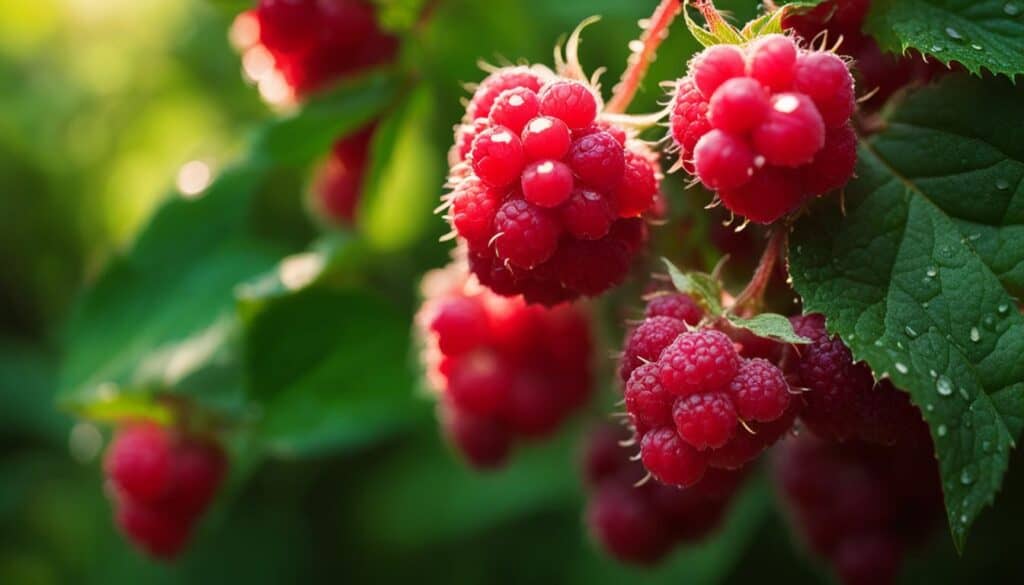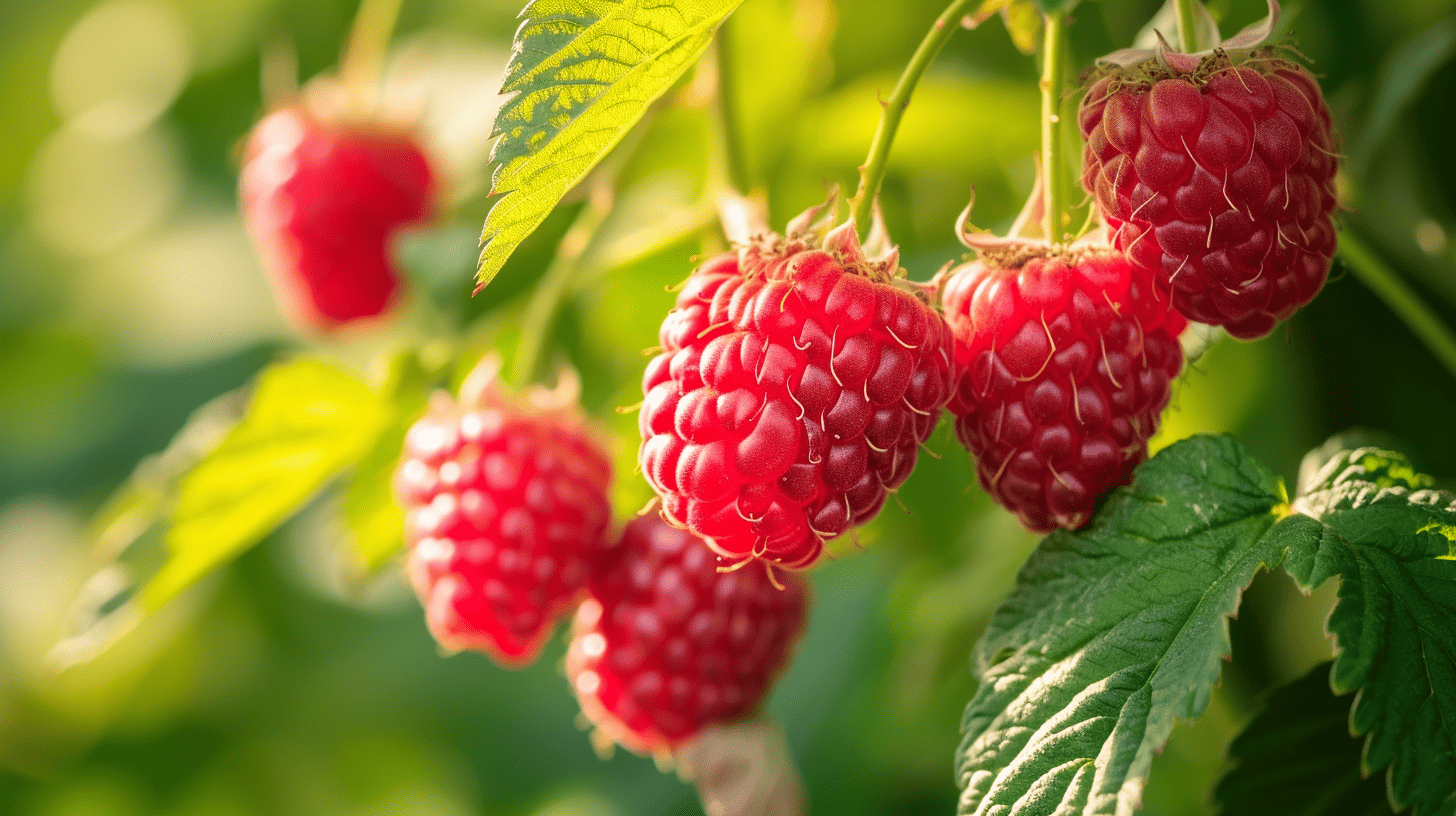Growing raspberries is not only a delightful hobby but also a rewarding journey that yields delicious berries packed with health benefits. With the right selection of raspberry varieties, proper care techniques, and optimal growing conditions, you can cultivate a thriving raspberry patch that will provide you with abundant harvests year after year.
Before we dive into the details of raspberry planting tips, caring for raspberry plants, and dealing with common raspberry pests and diseases, let’s explore the basics of raspberry cultivation.
Key Takeaways:
- Raspberries offer a wide range of health benefits, including fiber, vitamins, and minerals
- Choose raspberry varieties based on your preferences and growing conditions
- Establish a solid trellis system to support raspberry plants
- Follow proper care techniques to ensure a bountiful harvest
- Be aware of common pests and diseases that can affect raspberries
Why Choose an Everbearing Variety?

Everbearing raspberry varieties, such as ‘Summit’, offer the advantage of continuous fruit production from summer into fall. Unlike summer-bearing raspberries that only fruit for about a month, everbearing raspberries can provide a steady supply of berries throughout the growing season. This allows for more flexibility in harvesting and ensures a longer period of enjoying fresh raspberries. Additionally, everbearing raspberries can be a great choice for those who love raspberries and are willing to pick fruit regularly, as they offer a constant supply of berries for various uses.
One of the benefits of choosing an everbearing raspberry variety is the ability to have a continuous harvest throughout the year. While summer-bearing raspberries produce a large crop all at once, everbearing raspberries spread out their fruiting period, allowing for a more prolonged harvest season. This means that you can enjoy fresh raspberries from your garden for an extended period, rather than having to preserve or consume them all at once.
Another advantage of everbearing raspberries is the convenience they offer. With a constant supply of berries, you can pick and use them as needed, whether it’s for snacking, baking, or making preserves. This versatility can be especially beneficial for those who enjoy incorporating raspberries into their daily meals and recipes. Instead of needing to plan for a short window of harvest, you can simply harvest a few berries at a time as you need them.
In summary, everbearing raspberry varieties provide a continuous harvest throughout the growing season, allowing for more flexibility and a longer period of enjoying fresh raspberries. They are a convenient choice for those who love raspberries and want a constant supply of berries for various uses. Whether you’re snacking on fresh berries or using them in recipes, everbearing raspberries can provide a steady source of delicious fruit throughout the year.
How Many Plants, and How Big a Patch?
Raspberry plants have a tendency to multiply and spread rapidly through underground runners. If you plant just one raspberry cane, you can expect to have many more in the same spot the following year. To control the growth and maintain an organized raspberry patch, it is recommended to plan for a specific number of plants and determine the size of the patch accordingly.
Depending on the available space, a two-row raspberry patch that is 7 feet wide by 33 feet long can be suitable, with 3 feet between rows and 4 to 6 feet between plants. This spacing allows the plants to have enough room to grow and spread without becoming overcrowded. It’s important to note that raspberries can be easily propagated by dividing the suckers that develop from the roots, allowing for expansion of the raspberry patch or sharing with friends.
| Number of Plants | Size of Raspberry Patch | Spacing |
|---|---|---|
| 10-15 plants | 7 feet wide x 33 feet long | 3 feet between rows, 4-6 feet between plants |
| 20-30 plants | 10 feet wide x 33 feet long | 4 feet between rows, 4-6 feet between plants |
| 30-40 plants | 10 feet wide x 50 feet long | 4 feet between rows, 4-6 feet between plants |
By carefully considering the number of plants and the size of the raspberry patch, you can create an organized and manageable growing area that will provide you with a bountiful harvest of delicious raspberries.
Raised Beds Eliminate Root Rot
Raspberry plants require well-drained soil to prevent root rot, which can be a common issue, especially in areas with wet or clayey soil. One effective way to address this problem is by creating raised beds for growing raspberries. By building a raised bed that is at least 20 inches high and filled with a mixture of good garden topsoil blended with sand, peat, and well-rotted manure, you can ensure that the soil drains well and does not become waterlogged. Additionally, it is important to avoid planting raspberries in an area where tomatoes, peppers, or potatoes have recently grown to prevent the spread of verticillium wilt, a disease that can affect raspberries.
With raised beds, you have greater control over the soil conditions, allowing you to create the ideal environment for raspberry plants. The raised beds provide better drainage, preventing water from pooling around the roots and causing rot. By using a mixture of quality soil components, you can ensure that the soil is loose, well-aerated, and provides the necessary nutrients for the plants to thrive.
“Creating raised beds for raspberries is a smart solution to prevent root rot and optimize the growing conditions. It allows for better drainage and control over the soil composition, ensuring the health and productivity of the raspberry plants.”
Furthermore, raised beds make it easier to control weeds and manage the raspberry patch. The elevated design helps deter weed growth, reducing competition for nutrients and water. It also makes it more convenient to tend to the plants, as you don’t have to bend down as far to reach them. Additionally, raised beds can help extend the growing season by providing slightly warmer soil temperatures, allowing for earlier planting in the spring and potentially prolonging the harvest in the fall.
In conclusion, raised beds offer numerous benefits for growing raspberries, including preventing root rot, improving soil drainage, and facilitating weed control. By implementing raised beds in your raspberry patch, you can create an optimal growing environment that promotes healthy plant growth and ensures a bountiful harvest.
Spring is the Best Time to Plant
When it comes to planting raspberries, timing is crucial. The optimal time to plant raspberry plants is in early spring when the ground can be worked. This is because the cool weather and moist soil conditions provide an ideal environment for the plants to establish themselves during the growing season. By planting in spring, you give your raspberries the best chance of developing strong roots and thriving throughout the year.
If you happen to have healthy gift plants or potted raspberries, you can also plant them during the summer months, as long as you provide them with proper care and watering. However, it’s important to note that spring planting is generally preferred because it allows the plants to acclimate to their new surroundings before the heat of summer arrives.
Before planting your raspberries, it’s a good idea to soak bare-root plants in a half-strength solution of vitamin B1 growth stimulant for about six hours. This helps give the plants a healthy start and promotes better root development. When planting, make sure to bury the roots about 1-2 inches below the ground surface or at the same depth they were in the container. This ensures that the plants have a stable foundation and are properly positioned for growth.

During the establishment phase, regular watering and weed control are essential. Keep the soil consistently moist but not waterlogged, as overly wet conditions can lead to root rot. Once your raspberries are established, they will require less frequent watering but will still benefit from consistent moisture.
By following these proper planting techniques and giving your raspberries the best start, you’ll be well on your way to a flourishing raspberry patch that rewards you with delicious berries for years to come.
Requirements for Growing Raspberries
When it comes to successfully growing raspberries, there are several key requirements that you need to consider. Understanding the soil requirements, light requirements, water and fertilizer needs, as well as preventing diseases, will help you create an optimal environment for your raspberry plants to thrive.
Soil Requirements
Raspberries thrive in deep, well-drained soil with a slightly acidic pH of around 6.0. It is important to amend the soil with organic matter, such as compost or well-rotted manure, before planting to improve fertility and drainage. This will provide the necessary nutrients and create a favorable growing environment for your raspberries.
Light Requirements
Raspberries require full sun to grow and produce fruit. While some varieties can tolerate partial shade, it is best to provide them with at least 6-8 hours of direct sunlight each day. Placing your raspberry patch in a sunny location will ensure optimal growth and fruit production.
Water and Fertilizer Needs
Adequate watering is crucial for raspberry plants, especially during hot weather. Aim to provide at least 1 inch of water per week, either through rainfall or manual watering. Additionally, fertilizing your raspberries with a balanced fertilizer in spring will promote healthy growth and fruit development. It is important to avoid excessive nitrogen, as this can lead to excessive vegetative growth at the expense of fruit production.
Preventing Raspberry Diseases
To prevent common raspberry diseases, such as raspberry mosaic disease and verticillium wilt, it is important to select disease-resistant raspberry cultivars. Additionally, practicing proper sanitation measures, such as removing and destroying infected plant material, can help prevent the spread of diseases. Regularly inspect your raspberry plants for any signs of disease and take appropriate action to protect your crop.
Growing Raspberries in Containers
Container gardening for raspberries offers a convenient and space-saving option for those with limited garden space or who want to keep their raspberries contained. With the introduction of dwarf raspberry varieties specially bred for container gardening, it has become easier than ever to grow raspberries in pots on your patio or balcony.

When choosing a container for your raspberries, opt for one that is at least 18 inches in diameter and has good drainage holes. This ensures that the roots have enough room to grow and excess water can escape. Fill the container with a well-draining potting mix that is rich in organic matter.
Proper care is essential for container-grown raspberries. Regular watering is necessary to keep the soil evenly moist, especially during hot summer months. Fertilize the plants every spring with a balanced, slow-release fertilizer, following the package instructions. Protect the plants from extreme temperature fluctuations by moving the containers to a sheltered location during harsh weather conditions.
Benefits of Growing Raspberries in Containers
- Space-saving option for small gardens or balconies
- Easy accessibility for maintenance and harvesting
- Controlled environment for better disease prevention
- Ability to move plants to optimal sun and shade conditions
- Less risk of soil-borne diseases
Growing raspberries in containers allows you to enjoy the beauty and taste of fresh raspberries even if you have limited space. With proper care and attention, your container-grown raspberries can provide a bountiful harvest for years to come.
Harvesting Raspberries
Harvesting raspberries is an exciting time for any gardener. The optimal time to harvest raspberries is when they have reached their mature size and color. Look for plump berries that are brightly colored and easily detach from their base. Avoid picking raspberries that are too soft or starting to shrivel, as they may not have the best flavor or texture. To ensure a successful harvest, it’s important to pick raspberries regularly, as they ripen quickly and can become overripe if left on the plant for too long.
When harvesting raspberries, gently hold the berry at its base and give it a slight twist to detach it from the stem. Be careful not to squeeze the berries too tightly, as they are delicate and can easily bruise. If you’re planning to use the raspberries immediately, you can harvest them directly into a basket or container. However, if you’re storing them for later use, it’s best to place them in a moisture-proof container in a single layer, if possible, to prevent them from getting crushed or damaged.
Proper storage is essential for maintaining the freshness of harvested raspberries. After picking, it’s important to refrigerate the berries as soon as possible. Storing raspberries in the refrigerator helps to prolong their shelf life and preserve their flavor. It’s best to avoid washing raspberries before storing them, as moisture can promote spoilage. Instead, rinse them right before using them in recipes or serving them. By following these harvesting and storage techniques, you can enjoy the delightful taste of raspberries well beyond the harvest season.

Tips for Harvesting Raspberries:
- Harvest raspberries when they are plump, brightly colored, and easily detach from their base.
- Avoid picking raspberries that are too soft or starting to shrivel.
- Gently twist the berries at the base to detach them from the stem.
- Handle raspberries with care to prevent bruising or damaging the delicate berries.
- If storing raspberries, refrigerate them as soon as possible in a moisture-proof container.
- Rinse raspberries right before using them in recipes or serving them.
Table: Raspberry Harvesting Guide
| Harvesting Time | Characteristics | Storage Tips |
|---|---|---|
| When berries have reached their mature size and color | Plump and brightly colored berries that easily detach from the stem | Refrigerate in a moisture-proof container, rinse before using |
| Avoid picking berries that are too soft or starting to shrivel | Overripe berries may not have the best flavor or texture | Store in a single layer to prevent crushing or damage |
| Harvest regularly to prevent berries from becoming overripe | Raspberries ripen quickly and can spoil if left on the plant for too long | Avoid washing raspberries before storing to prevent moisture buildup |
Using Raspberries in the Kitchen
Raspberries are a versatile fruit that can be used in a variety of delicious culinary creations. Their sweet and tangy flavor, combined with their vibrant color, makes them a popular choice for both sweet and savory dishes. From refreshing desserts to savory sauces, here are some creative ways to incorporate raspberries into your kitchen repertoire.
Sweet Treats:
Raspberries are a perfect addition to desserts such as pies, tarts, and cakes. Their bright flavor pairs well with a variety of ingredients, including chocolate, vanilla, and citrus. Try adding fresh raspberries to your favorite muffin or pancake recipe for a burst of fruity goodness. You can also use raspberries to make homemade jam or jelly to spread on toast or use as a filling for pastries.
Refreshing Drinks:
Raspberries can add a refreshing twist to your favorite beverages. Blend them with yogurt and a splash of honey for a delicious smoothie, or muddle them with mint and lime for a flavorful mocktail. For a more indulgent treat, try making raspberry lemonade or a fruity sangria with fresh raspberries as a garnish.
Savory Delights:
Raspberries can also be used in savory dishes to add a touch of sweetness and acidity. Their flavor pairs well with robust ingredients like goat cheese, balsamic vinegar, and black pepper. Toss fresh raspberries into a summer salad for a burst of flavor, or use them as a topping for grilled chicken or pork. You can even make a tangy raspberry sauce to drizzle over roasted vegetables or grilled fish.
Freezing Raspberries:
To enjoy the taste of raspberries all year round, consider freezing them. Freezing raspberries is a simple process that helps to preserve their flavor and texture. Start by gently rinsing the berries and then spread them out in a single layer on a baking sheet. Place the baking sheet in the freezer for a couple of hours until the berries are frozen solid. Once frozen, transfer the raspberries to a freezer-safe container or bag. Frozen raspberries can be used in smoothies, baked goods, or thawed to enjoy on their own as a refreshing snack.

| Recipe | Description |
|---|---|
| Raspberry Cheesecake Bars | A creamy and indulgent dessert featuring a buttery crust, tangy raspberry filling, and a velvety cream cheese topping. |
| Raspberry Balsamic Glazed Salmon | A savory and sweet dish featuring grilled salmon fillets topped with a tangy raspberry balsamic glaze. |
| Raspberry Vinaigrette | A light and refreshing salad dressing made with fresh raspberries, olive oil, vinegar, and a touch of honey. |
| Raspberry Swirl Brownies | A decadent treat featuring fudgy chocolate brownies with a swirl of tangy raspberry puree. |
Conclusion
In conclusion, growing raspberries can be a delightful and fulfilling experience for any gardener. By following the proper techniques and guidelines, you can establish a thriving raspberry patch that provides you with an abundance of delicious berries for years to come.
Throughout this guide, we have explored various aspects of raspberry cultivation, from selecting the right variety and setting up a trellis system to planting, caring for, and harvesting raspberries. We have also discussed important considerations such as soil requirements, disease prevention, and even growing raspberries in containers.
Whether you choose summer-bearing or everbearing varieties, the joy of growing your own raspberries is unmatched. From the satisfaction of nurturing your plants to the excitement of harvesting fresh berries, the rewards of raspberry cultivation are truly abundant. So why not embark on this wonderful journey and start growing your own raspberries today?
FAQ
Q: What are the health benefits of raspberries?
A: Raspberries are high in fiber and contain essential vitamins and minerals, making them a nutritious addition to your diet.
Q: How long does the fruiting season last for everbearing raspberries?
A: Unlike summer-bearing raspberries, everbearing raspberries produce fruit continuously from summer into fall, providing a longer period of fresh berries.
Q: How quickly do raspberry plants multiply?
A: Raspberry plants spread rapidly through underground runners, so planting just one cane can result in many more plants the following year.
Q: What is the ideal spacing for raspberry plants?
A: For a two-row raspberry patch, it is recommended to have 3 feet between rows and 4 to 6 feet between plants.
Q: How can I prevent root rot in raspberries?
A: Creating raised beds for growing raspberries can help prevent root rot by ensuring proper drainage.
Q: When is the best time to plant raspberries?
A: Early spring is the optimal time to plant raspberry plants, allowing them to establish themselves during the growing season.
Q: What type of soil do raspberries prefer?
A: Raspberries thrive in deep, well-drained soil with a slightly acidic pH of around 6.0.
Q: Can raspberries be grown in containers?
A: Yes, there are dwarf raspberry varieties that are suitable for container gardening.
Q: When should raspberries be harvested?
A: Raspberries should be harvested when they are plump, brightly colored, and easily detach from their base.
Q: How can I use raspberries in the kitchen?
A: Raspberries can be eaten fresh, added to cereals, smoothies, desserts, and used in jams or sauces.





Leave a Reply